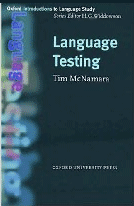

This book offers a succinct theoretical introduction to the basic concepts in language testing in a way that is easy to understand. In the Japanese context, this book is highly recommended for university faculty members involved in obtaining assessment literacy, teachers who want to validate their exploratory teaching and testing, or applied linguistics students new to the language testing field.
The book is divided into four main sections. The first provides an overview of the principles of language testing. The next contains short extracts from the testing literature with questions which stimulate further thinking. Section 3 is a list of references with brief annotations and Section 4 a glossary of referenced testing terms.
The survey in Section 1 is thorough, clear, and easy to follow - though more theoretical than practical. It focuses on language testing principles rather than practical advice about how to design and implement good tests. This background knowledge, nevertheless, can help teachers critically evaluate their testing practices.
One of the most appealing aspects of Section 1 are the effective illustrations offered by the author. Concepts in language testing are not always easy to grasp, but by contextualising them in vivid everyday situations they become more understandable. One particularly effective image was the suggestions that we should try to measure a child's growth with a ruler which only marked off every 30 cm. This image made it easy to understand that we must have an appropriate measure to assess language development in order to detect student progress.
The extracts in Section 2 introduce topics such as the testing cycle and validity: testing the test, and then have questions which encourage readers to consider matters in more depth. This is particularly useful for those discussing their ideas with their colleagues and / or supervisors. One sample extract presents four clear sources of unreliability when assessing oral performance. Teachers experiencing difficulty in assessing student performance can deepen their understanding of why this unreliability occurs. The follow up questions are designed to help readers consider possible solutions. It is regrettable that this book does not include any suggested further readings which would offer possible solutions.
The list of references in Section 3, though mentioning many key language testing texts, is sometimes disappointingly brief. For example, there are only two references for the problematic area of test rating. There are only four references for the entire topic of validation, arguably the most important aspect of the entire testing process. Most of the references appear to be academic in nature, which is appropriate for applied linguistics students, but practicing teachers may appreciate the inclusion of more practical texts.
It is easy to use this book as a reference book. The nature of this survey, with short chapters and sub-headings, makes it easy to find specific topics readers are interested in. Generally the cross-referencing is very helpful. Throughout the text readers are referred back and forth to places where the material is discussed in more detail.
The glossary in Section 4 also lists page numbers where terms can be found in the main survey, but it is disappointing that only one occurrence, and not a list of all occurrences of the term are included. For example, critical language testing is referenced to page 72, but the main discussion of this movement is found on pages 76 and 77. It would therefore have been helpful to include these pages in the glossary.
In spite of the few criticisms made here, this book remains an excellent overview of the main principles of language testing. Although not as thoroughly developed as possible, Sections 2 and 3 do encourage readers to both seek further information and relate this theoretical knowledge to their testing practice. The main purpose of this book is to enable readers to understand testing theory more deeply and relate this knowledge to their testing practice. In Japan this book could be a much needed catalyst for change were it made required reading for all exam committee members.
- Reviewed by Yvonne Ishida
[ p. 7 ]